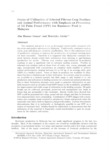The ruminant sub-sector is not as developed commercially compared with the swine and poultry sub-sectors in Malaysia. Traditionally, ruminants such as cattle, goat and sheep are owned by smallholders. Due to this subsistence level of production, attempts to improve the productivity of ruminant farming have not been successful. Therefore it is suggested that Malaysian ruminant livestock farmers should switch their orientation from farming to agri-business (production for profit). Fibrous crop residues (agro-industrial by-products) continue to play a significant role in ruminant feeding systems. Profiles of selected crop residues such as those from oil palm, rice, cocoa, pineapple and sago, incorporated with concentrates as complete feeds enabled to achieve animal performances ranging between 0.5 to 0.9 kg of an average daily gain (ADG) in a feedlot system. Some of these by-products are available in abundance but have a limited scope in their utilization. In contrast, some by-products are available in a limited quantity but their usage is only limited to in situ production and utilization in feeding systems for commercial animal production. Due to these limitations attempts were made to generate information on new feed resources such as oil palm frond (OPF) based on the availability, possibility for improvement and wider scope of utilization in the feeding systems. Oil palm fronds can be collected, processed, preserved and manipulated into feeds in forms that are acceptable to the ruminants. Recent results have showed that OPF could be processed into chips, preserved into silages and that its fermentation characteristics were outstanding. Combination of OPF silages with concentrates into complete feeds resulted in satisfactory intake and growth when the materials were fed to bulls in digestion and growth studies. Current information demonstrates that it is technically or biologically possible to use OPF as a source of ruminant feed. Studies should be undertaken to demonstrate that the utilization of the material is financially sound (marketable) to gain its acceptance by the industry and society.

